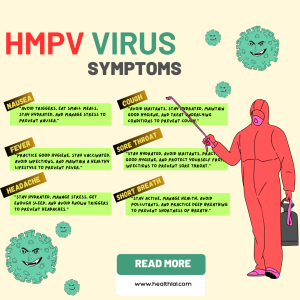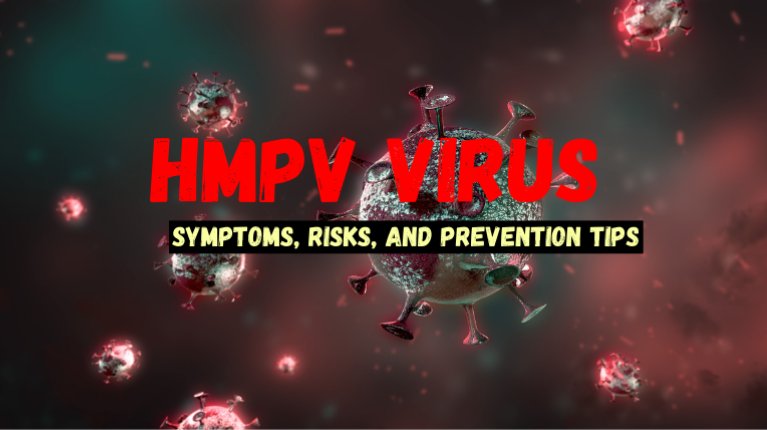Human Metapneumovirus (HMPV): What You Need to Know
Human Metapneumovirus (HMPV) is a virus that can cause serious illness, especially in young children, older adults, and people with weak immune systems. While not as well-known as some other viruses, it’s important to understand its symptoms, risks, and how to prevent infection.
What is HMPV?
Human Metapneumovirus (HMPV) is a virus that affects the respiratory system, similar to the Respiratory Syncytial Virus (RSV). It can cause mild symptoms like a cold or more severe problems like pneumonia. HMPV was discovered in 2001 and is a common cause of infections, especially during the colder months of the year.
The virus spreads through respiratory droplets when an infected person coughs, sneezes, or talks. It can also spread by touching contaminated surfaces, so maintaining good hygiene is important to stay safe.
 Symptoms of HMPV
Symptoms of HMPV
The symptoms of HMPV can vary, and may be mild or severe. Common symptoms include:
- Cough: Often dry or with mucus.
- Fever: Can range from low-grade to high.
- Runny or Stuffed Nose: Nasal congestion is common.
- Sore Throat: Pain or irritation in the throat.
- Wheezing and Shortness of Breath: In severe cases, breathing becomes difficult.
- Fatigue: Feeling unusually tired or weak.
- Headache and Body Aches: General flu-like symptoms.
In young children and older adults, HMPV can cause serious respiratory issues like bronchiolitis (inflammation in the small airways of the lungs) and pneumonia, which may require hospitalization.
Who is at Risk?
Anyone can catch HMPV, but some people are more likely to get severely sick:
- Young Children: Babies and toddlers are more vulnerable because their airways are smaller.
- Older Adults: Elderly people often have weaker immune systems and may develop severe complications like pneumonia.
- People with Weak Immune Systems: Those with conditions like cancer, HIV, or people undergoing treatments like chemotherapy are at higher risk.
- People with Breathing Problems: Individuals with asthma, COPD, or other lung diseases may face more serious symptoms.
How Does HMPV Spread?
HMPV spreads through respiratory droplets from coughing, sneezing, or talking. These droplets can land on surfaces or in the air, and others can inhale them. Even people without symptoms can spread the virus.
It can also spread if you touch a surface with the virus on it, like doorknobs, phones, or toys, and then touch your face, especially your eyes, nose, or mouth.
How to Prevent HMPV Infection
Currently, there is no vaccine for HMPV, but you can take steps to lower your risk:
- Wash Hands Regularly: Use soap and water for at least 20 seconds, especially after coughing, sneezing, or touching surfaces. If soap isn’t available, use hand sanitizer with at least 60% alcohol.
- Cover Your Mouth and Nose: Always cover your mouth and nose with a tissue or your elbow when coughing or sneezing.
- Stay Away from Sick People: Keep a safe distance from people showing symptoms of illness. If you are sick, stay home.
- Clean Surfaces Often: Wipe down commonly touched surfaces like doorknobs, light switches, and countertops regularly.
- Avoid Touching Your Face: Don’t touch your eyes, nose, or mouth with unwashed hands.
- Avoid Crowded Places: During the cold season, avoid crowded places to reduce the risk of infection, especially if you are at higher risk.
When to See a Doctor
If you or your child have symptoms like fever, cough, or difficulty breathing, it’s important to see a doctor. Early treatment can help prevent serious complications, especially in young children, the elderly, or those with weak immune systems.
If you or someone else is having severe symptoms such as high fever, shortness of breath, or chest pain, seek medical help immediately. In some cases, hospital care may be needed.
FAQs :About HMPV
1. What is the difference between HMPV and the common cold?
HMPV has similar symptoms to the common cold, like a runny nose and cough. But HMPV can cause more serious illness, especially in young children, older adults, and people with weak immune systems.
2. How long does HMPV last?
HMPV usually lasts 1 to 2 weeks. Severe cases may last longer, especially if there are complications like pneumonia.
3. Can HMPV be treated?
There is no specific treatment for HMPV. You can manage symptoms with rest, fluids, and over-the-counter medicines. In severe cases, you may need hospital care.
4. Can I get HMPV more than once?
Yes, it’s possible to get HMPV again after recovering, because immunity doesn’t last long.
5. Is there a vaccine for HMPV?
No, there is no vaccine for HMPV yet. Good hygiene and avoiding sick people are the best ways to prevent it.
6. What should I do if my child has symptoms of HMPV?
If your child has fever, cough, or trouble breathing, see a doctor. HMPV can cause serious problems in children.
7. How can I protect myself from HMPV during flu season?
Wash your hands regularly, avoid close contact with sick people, and stay home if you’re unwell. These habits can help prevent the virus.
8. Can I get HMPV from animals?
No, HMPV only spreads from person to person.
9. How do I know if I have HMPV or something else like the flu?
HMPV, the flu, and RSV have similar symptoms. A doctor can help you find out which virus you have if needed.
10. Can HMPV cause long-term health problems?
Most people recover fully from HMPV. However, severe cases can lead to complications like pneumonia, which may cause long-term breathing problems.
Conclusion
HMPV is a virus that can cause mild to severe respiratory illnesses, especially in vulnerable groups. By knowing the symptoms, risks, and prevention methods, you can help protect yourself and your loved ones.

